“If you only remember one thing, it’s that for people like me to be this passionate about them, there must be a good reason.”
~Devin: Friend, registered nurse, former farmers market manager, bat biologist and educator.
Even in print, it’s small enough to be completely overlooked or weighty enough to draw attention, depending on whose eyes are involved. Of course the word weighty isn’t really on the money, because even the largest is only about three pounds, the smallest less than a penny.
Bats: Arguably the most undervalued influencer in the whole animal kingdom. If all you’ve ever learned about them is that they eat a lot of insects and carry rabies, then today, friend, is your lucky day! Grab your night-vision goggles. We’re going in for an exploration of the Order of Chiroptera, and you’re going to leave with a new or renewed level of appreciation for the so-called flittermouse.
In terms of sheer mammal numbers, bats are the second largest, with over 1,400 known species. On a mammal pie chart, 1/5th is given over to bats. (Please, not an actual pie! Yes, bats are on the menu in many countries.) That term, flittermouse? A misnomer, albeit no longer common. Bats aren’t flying mice. In fact, they’re more closely related to primates than they are to rodents.

In general, smaller animal species tend to have shorter lives, but bats are an exception, living six to seven years on average. Mice live just two. Immature bats are vulnerable and bring down overall measures of life expectancy, but those that make it to adulthood may live as long as 20 years in the wild, some more than 30. The record, to date, belongs to a miniscule, male Brandt’s bat—average weight equivalent to about three pennies—which was recaptured 41 years after it was first tagged.
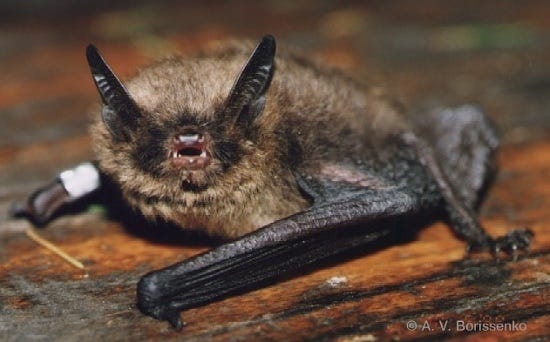
Speaking of tagging, let’s go ahead and identify the 800-pound primate in the room here. Bats are thought to be reservoirs and vectors for human diseases. Even if you’d somehow missed being infected with this negative “battitude,” you’d undoubtedly walk away from a current Google search loaded with contagion.
To say that bats aren’t a piece of the zoonotic puzzle would be inaccurate. Scientists agree that these mammals have a unique ability to carry diseases, or at least remnants of them, asymptomatically. But the data connecting bats to the spillover of those infections to humans is unsettled. Bats have been implicated well beyond what has been proven.
Familiar and unfamiliar terms pepper the list of diseases bats have been accused of transmitting: Marburg, MERS, Nipah, Hendra, Ebola, Rabies, SARS, and SARS-CoV-2, or Covid-19. Yet, a literature review released in July 2022 explains that “many viruses carried by bats cannot infect humans without first undergoing a natural process of evolution, meaning that bats carry the ancestral viruses and not the human pathogen.” The authors further conclude that “bats pose little zoonotic danger to humans and that they operate a highly efficient anti-inflammatory response that we should strive to understand.”
Scientists link bats’ unique ability to tolerate illness to one feature: Flight. They are the only mammal that has evolved the ability to do so. When it flies, a bat’s metabolic rate increases 15 fold. For comparison, a human running at full speed only doubles theirs. Bat heart rates shoot up to 1,000 beats per minute, and their temperature elevates to 44° Celsius, or 111.2° Fahrenheit. As mammals, this puts them at the outer limits of what is physically survivable. Because flying is so energy consumptive, and so intensely stressful for bats, it is believed they have developed mechanisms to limit inflammation and repair DNA, which also enhances their ability to ward off cancer and other diseases.
Rather than associating them with viruses and vampires, it’s time we see bats as the marvelous resources that they are! That they can tolerate so much, and live so long is cause for fascination and well-funded research, not blame.
Borrowing from stoicism, with a touch of Marie Curie, renowned bat expert and ecologist, Dr. Merlin Tuttle, frames our knee-jerk bat-hate this way: “We fear most that which we understand least.” Tuttle has been researching bats since he was a teenager. Now 83, he continues to be among their loudest cheerleaders. He calls for reason and more balanced reporting in his efforts to impress on us the critical need to promote the conservation of these remarkable creatures.
On his website, Merlin Tuttle’s Bat Conservation, he writes, “Unprovoked bites from bats simply flying by are so rare that in more than 60 years of studying bats worldwide, often surrounded by thousands at a time in caves, I still have not been able to personally document such an event.”
Bats aren’t naturally aggressive, and they don’t intentionally fly at people. So much for the myth that they’re attracted to human hair and apt to get tangled in it. I’m not saying it’s impossible. I personally wouldn’t choose banana-scented hair gel for a bat-watching adventure, but odds are you’d be fine regardless.
The wow-factor with bats is pretty much pegged at the ceiling. There’s so much to share that I can’t begin to enumerate everything in one go. But, I want to highlight some details that you might not otherwise discover. I’ll start with the most basic:
Bats aren’t blind. They have eyes that function quite well, some with more clarity than others, and some better than humans. They use a combination of sight, smell, and echolocation to explore, locate objects in 3-dimensional space, and find food.
Bat food comes in many forms. There are species that eat mostly insects, others that eat mostly fruit. There are nectar-eating bats and those that eat fish, frogs and other small animals. Of the 1,400 species, just three are sanguivores, or vampire bats, that feed exclusively on blood. These live mostly in Mexico, Central, and South America, though the range appears to be expanding into portions of Texas. For the record, vampire bat bites are typically not lethal to their hosts.
What about the bug-crunchers? Insect-eating bats can consume as many as 1,000 insects an hour. All that ingesting is said to save the U.S. agriculture industry at least $3.7 billion per year. Conversely, it is estimated that the precipitous decline in bat populations, due in part to white-nose syndrome, which alone has wiped out an estimated 90% of bats in the northeastern U.S., has resulted in an annual drop in consumption of up to 1,320 metric tons of insects.
Fun fact: After those insect exoskeletons get digested, they turn into poop with flecks of shiny iridescence. In case you were curious about that.
Bats are busy critters. Which brings me to another matter, the ooh-la-la kind of busy. Buckle up. It’s a curious ride.
About 15 years ago, researchers in China discovered that female short-nosed fruit bats appear to prolong copulation by performing oral sex on their male partners. A year or so later, a pair of Indian scientists made a similar discovery among another fruit bat species, only this time, it was the male offering the added spice. A few years after that, we learned that little brown bats go through a two-phase mating process, the first being something of a boink-fest and the second more of a free-love model, with at least 35% of the activity being homosexual.
Then, there are the hoary bats that join up mid-air and copulate in free fall. It is thought that the spiky growths (think sand spur) on the male penis helps reinforce the, uh, connection between him and his mate.
Meanwhile, late last year, it was discovered that the serotine bat, native to the UK, has evolved to reproduce by touching genitals rather than through penetration. Evidently his apparatus is much, much larger than hers, so it’s physically impossible for him to fit. You have to wonder if he met up with a bat genie somewhere along the line and had a really big wish come true. Anyway, scientists aren’t quite sure how it all works, but they believe it is a trait unique to these bats and across all other mammals.
We could end with a bang there. But we won’t.
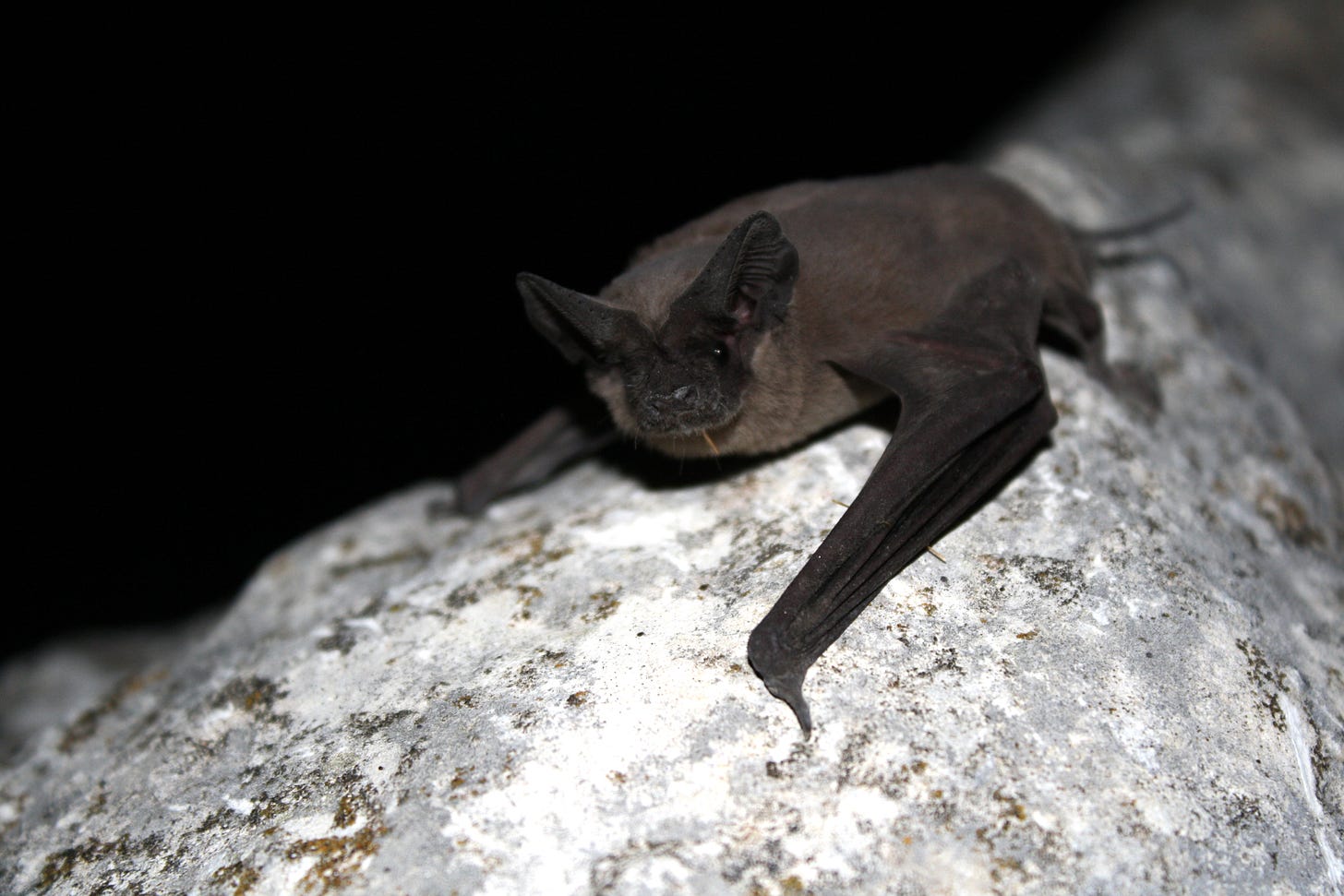
Because if we did, you’d never know that bats exist on every continent except Antarctica or that they’ve been found, healthy in hibernation, with body temperatures below freezing.
You might not understand that bats can’t take off from the ground and that they therefore require a particular kind of care when found in human spaces.
You wouldn’t learn that, through seed dispersal, bats are aiding in tropical reforestation, or that bat pups learn to communicate through babbling, much like human babies.
You wouldn’t know that Mexican free-tailed bats can fly, horizontally, at speeds of 100 miles per hour, or that female vampire bats are decidedly altruistic.
You’d miss the fact that bats are the only pollinators of the blue agave used for tequila, and that skyrocketing demand for these spirits has given rise to farming practices that rob bats of the pollen they need. (Look for bat-friendly tequila, or drink mezcal, which is wild harvested.)
You might not realize that, as if habitat loss, pollution, hunting, and intentional eradication weren’t detrimental enough, wind turbines are causing the death of up to 800,000 bats annually.
And you might never get to the part about how you can help.
I’m told that everyone has a bat story, something that defines their interaction with these ancient, intelligent, necessary, and misunderstood animals. I have two. The first took place when I made my way to the bathroom in the middle of the night, while enormously pregnant, and discovered a bat on the roll of toilet paper. Anyone who knows anything about late-stage child bearing knows that the urgency for bladder relief is no joke. So, there I was, teetering in my precarious, pants-around-the-ankles mode, choosing between sitting inches from the bat or cleaning up a self-made accident. I went with the former and lived to tell you this tale.
The second story is more expansive, like the feeling you get when you stand, breathing in, at the edge of the ocean. It takes place as night falls, my husband and I enjoying time by a small fire in the backyard. We lean our heads against the backs of our chairs and wait for them to come. And they always do, their thin wings slicing across the dim sky, as they offer their humble miracles to the darkened world.
~Elizabeth
The video below is a slow-motion compilation taken with my phone, on an April evening, in my backyard.
p.s. Last July, shortly after my last birthday, in an essay called Love Bugs, I revealed to the Scratch Community my secret infatuation with insects. Among the comments was one from my oldest brother, who wrote, “Next, maybe a course on my own object of fascination: Bats, nature’s own mosquito control.” His birthday was yesterday, and this is my gift to him.
p.p.s. My deep gratitude for the guidance and insights provided for this piece by Devin Herlihy. Devin (she/her) practiced as a bat biologist and educator for just under ten years, working in government, academia, consulting and nonprofits. She’s now employed as a registered nurse but says she’ll never turn down the opportunity to discuss bats. She writes that a PTA mom bought her a Bat Conservation International membership in 2004, when she was 8 years old, and she has kept the membership since! The photos below are hers. Devin is happy to respond to questions or provide more information via email.

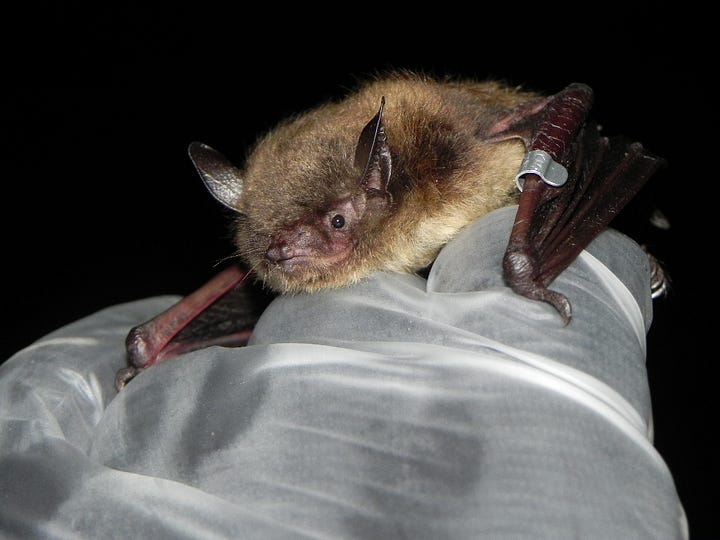

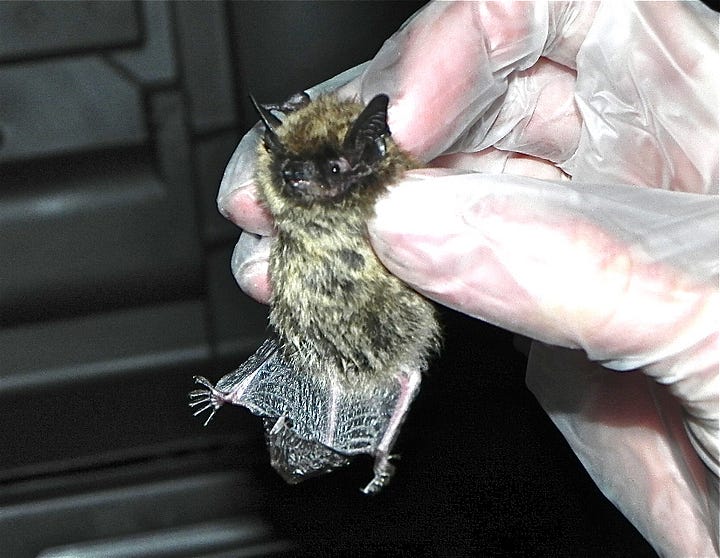
More resources:

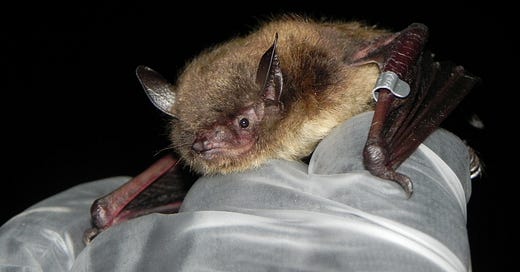


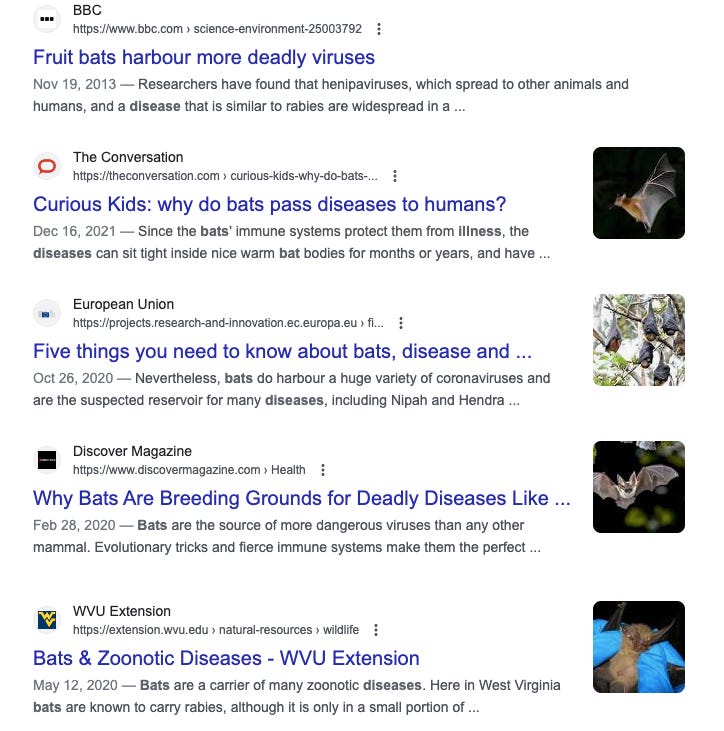
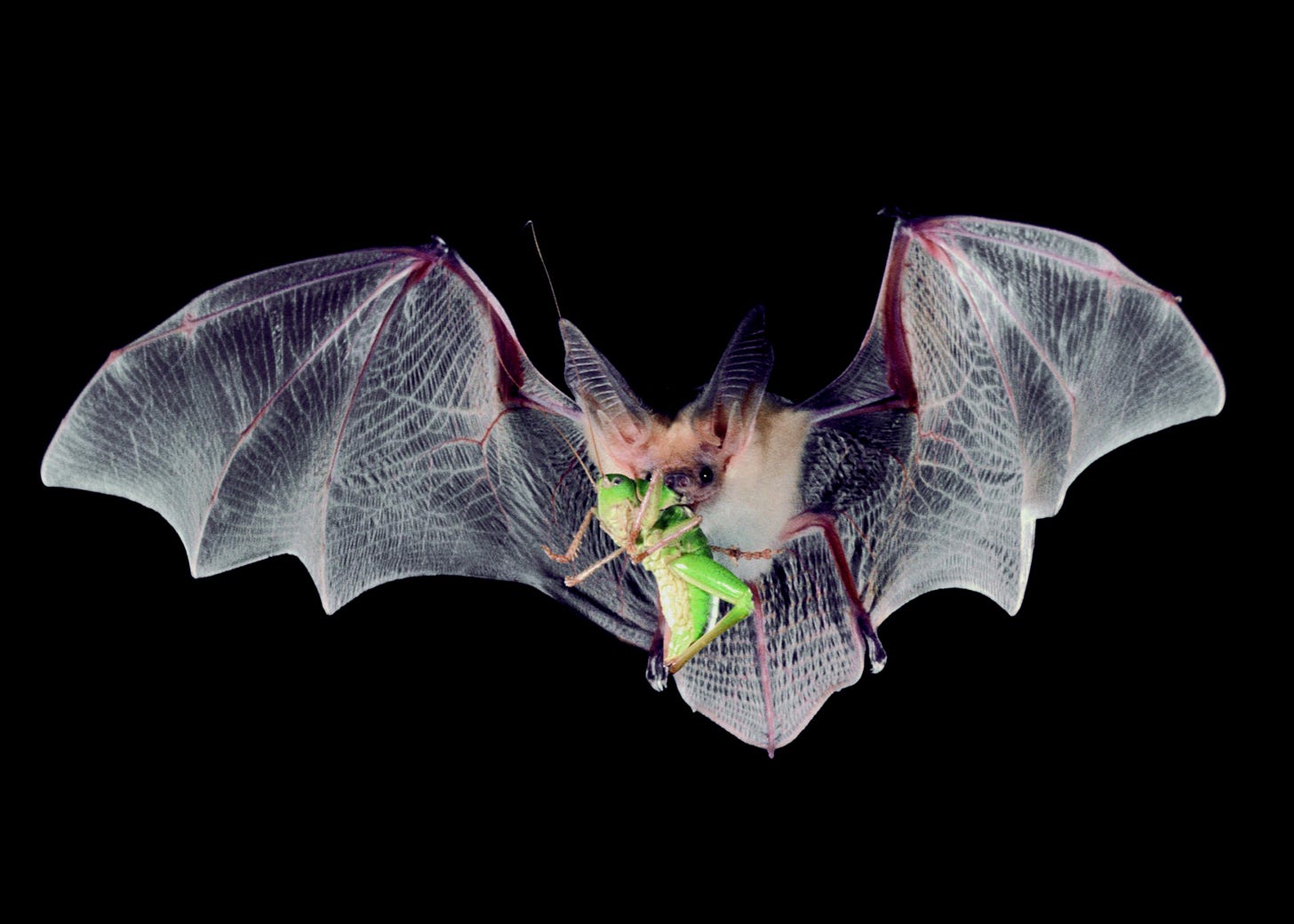
Wow what great information.... I remember bats flying around us at middle high camp when we showed movies on those dreaded 16 mm projectors upstairs in the activity hall... We were on their turf and they reminded us for about 2 hours...lol
What an interesting ride! Where I am, down under, bats resemble large birds flying through the night sky. With Australia hosting some of the largest bat species in the world, I often see the fuzzy creates shoot above me with staggering wingspans of up to a metre (3.3 feet) long!